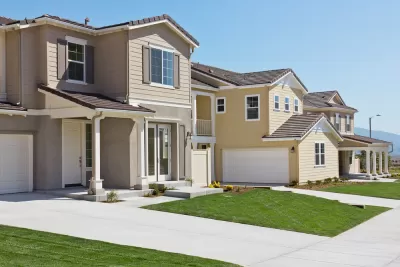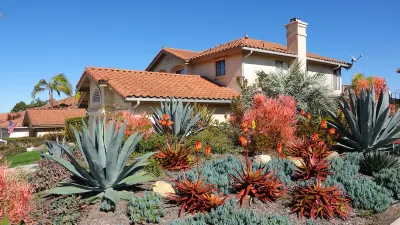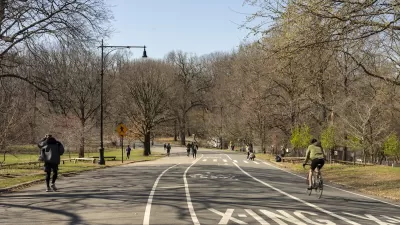Once scratchy and unrealistic, artificial grass has come a long way. Now, it’s quickly becoming a popular lawn replacement as droughts and climate change make traditional lawns harder to maintain.

Writing in Bloomberg CityLab, Brian Eckhouse and Siobhan Wagner describe the movement to replace suburban grass lawns with artificial turf in cities facing worsening drought and water restrictions. “Within the next 30 years, droughts may impact three quarters of the world’s population. While plastic turf poses its own climate challenges, it’s increasingly seen as a viable alternative to real green yards that devour precious water.”
Homeowners are taking notice. “For some, it’s the cash-for-grass rebates being offered by local water agencies. For others, it’s the realization that the classic lawn is increasingly unsustainable in a time of megadrought. And then there are the residents coaxed into the shift by the water notices or fines.”
Critics of artificial turf say some types, made of recycled tires, can leach chemicals into the ground and waterways. “The most obvious environmental problem with artificial grass is it’s rooted in the biggest climate nemesis of all: fossil fuel. Synthetic turf is made from a stew of petroleum-based components, making it nearly impossible to recycle. At the end of an artificial lawn’s useful life, which is about 15 years, it will likely go to a landfill or be incinerated.”
Comparing the products to plastic water bottles, “Stefan Diderich, director general of the EMEA Synthetic Turf Council, an artificial grass industry group, says companies are trying to develop a more widely recyclable turf made from a single material like polyester.”
As climate change shifts weather patterns around the world, “The future for lawns is in question everywhere. Even in the UK—a country synonymous with rain—lawn owners are accepting shades of yellow and brown amid green.”
FULL STORY: The Suburban Lawn Will Never Be the Same

Study: Maui’s Plan to Convert Vacation Rentals to Long-Term Housing Could Cause Nearly $1 Billion Economic Loss
The plan would reduce visitor accommodation by 25,% resulting in 1,900 jobs lost.

North Texas Transit Leaders Tout Benefits of TOD for Growing Region
At a summit focused on transit-oriented development, policymakers discussed how North Texas’ expanded light rail system can serve as a tool for economic growth.

Why Should We Subsidize Public Transportation?
Many public transit agencies face financial stress due to rising costs, declining fare revenue, and declining subsidies. Transit advocates must provide a strong business case for increasing public transit funding.

How to Make US Trains Faster
Changes to boarding platforms and a switch to electric trains could improve U.S. passenger rail service without the added cost of high-speed rail.

Columbia’s Revitalized ‘Loop’ Is a Hub for Local Entrepreneurs
A focus on small businesses is helping a commercial corridor in Columbia, Missouri thrive.

Invasive Insect Threatens Minnesota’s Ash Forests
The Emerald Ash Borer is a rapidly spreading invasive pest threatening Minnesota’s ash trees, and homeowners are encouraged to plant diverse replacement species, avoid moving ash firewood, and monitor for signs of infestation.
Urban Design for Planners 1: Software Tools
This six-course series explores essential urban design concepts using open source software and equips planners with the tools they need to participate fully in the urban design process.
Planning for Universal Design
Learn the tools for implementing Universal Design in planning regulations.
Ascent Environmental
Borough of Carlisle
Institute for Housing and Urban Development Studies (IHS)
City of Grandview
Harvard GSD Executive Education
Toledo-Lucas County Plan Commissions
Salt Lake City
NYU Wagner Graduate School of Public Service




























